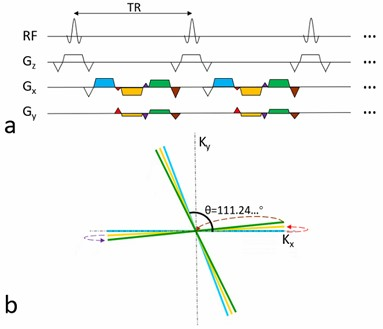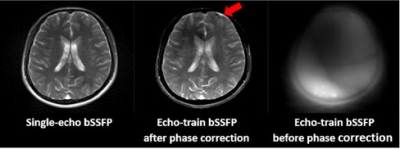Kaibao Sun1, Zheng Zhong1,2, Kezhou Wang1, and Xiaohong Joe Zhou1,2,3
1Center for MR Research, University of Illinois at Chicago, Chicago, IL, United States, 2Department of Bioengineering, University of Illinois at Chicago, Chicago, IL, United States, 3Departments of Radiology and Neurosurgery, University of Illinois at Chicago, Chicago, IL, United States
1Center for MR Research, University of Illinois at Chicago, Chicago, IL, United States, 2Department of Bioengineering, University of Illinois at Chicago, Chicago, IL, United States, 3Departments of Radiology and Neurosurgery, University of Illinois at Chicago, Chicago, IL, United States
A novel
echo-train golden-angle radial bSSFP sequence, together with an
integrated phase-correction algorithm, has been developed to provide scan time
reduction by 36% without noticeable degradation of image quality in phantoms
and the human brain.

Figure 1: (a):
A section of an ETGAR-II sequence consisting of two repetition times (TRs or
shots). Blue, yellow and green gradients are the readout gradient pulses in the
echo train. Red and purple gradients are the steering gradient pulses. Brown
gradients are for phase-rewinding, as required by bSSFP. (b): k-Space
trajectory of the sequence segment in (a). The dashed curves illustrate the
effect of the steering gradient pulses or the rewinding gradient pulses on the
k-space trajectory. The k-space rotation angle between two consecutive TRs is
set to golden angle (111.24…°).

Figure 5: Human brain images obtained
with single-echo golden-angle radial bSSFP (left) and ETGAR-II bSSFP with
(middle) and without (right) phase corrections. With echo-train bSSFP, the scan
time was reduced by 36% without substantial reduction in image quality as
compared to single-echo bSSFP. In the middle image, the susceptibility/banding
artifacts were slightly elevated in the frontal area (red arrow) due to the
increased sensitivity to off-resonance in echo-train acquisitions.